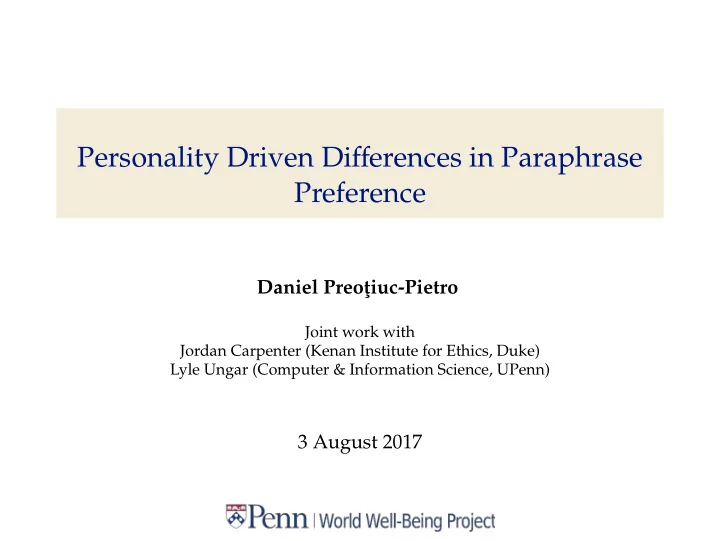

Personality Driven Di ff erences in Paraphrase Preference Daniel Preot ¸iuc-Pietro Joint work with Jordan Carpenter (Kenan Institute for Ethics, Duke) Lyle Ungar (Computer & Information Science, UPenn) 3 August 2017
Motivation User attribute prediction from text is successful: ◮ Age (Rao et al. 2010 ACL) ◮ Gender (Burger et al. 2011 EMNLP) ◮ Location (Eisenstein et al. 2010 EMNLP) ◮ Personality (Schwartz et al. 2013 PLoS One) ◮ Impact (Lampos et al. 2014 EACL) ◮ Political Orientation (Volkova et al. 2014 ACL) ◮ Mental Illness (Coppersmith et al. 2014 ACL) ◮ Occupation (Preot ¸iuc-Pietro et al. 2015 ACL) ◮ Income (Preot ¸iuc-Pietro et al. 2015 PLoS One)
However... Most text prediction methods uncover topical di ff erences a a a correlation strength relative frequency Openness to Experience
However... Most text prediction methods uncover topical di ff erences a a a correlation strength relative frequency Extraversion
Stylistic di ff erences We need to be aware of style di ff erences, rather than topical Not useful for many practical applications that adapt to traits: ◮ machine translation (Mirkin et al. 2015 EMNLP, Rabinovich et al 2017 EACL) ◮ agents (e.g. customer service, tutoring) ◮ controlling for gender or racial bias
Stylistic di ff erences One type of stylistic di ff erence is phrase choice in context. Splendid Magnificent Excellent Fabulous Remarkable Tremendous Source: https: // wikispaces.psu.edu / display / P5PFL / TRAIT + Theory + Page Source: http: // inwilmingtonde.com / events / thanksgiving-eve-karaoke Openness Extraversion
Data We study the Big Five personality traits: ◮ 115,312 Facebook users ◮ Personality scores obtained through the MyPersonality app (Kosinski et al, 2013) ◮ For each trait, take top and bottom 20% of users
Paraphrasing Paraphrases – alternative ways to convey the same information Paraphrase Database (PPDB) 2.0 (Pavlick et al. 2015 ACL): ◮ annotated with type and confidence (filter ‘equivalent’ paraphrases with > .2 confidence) ◮ > 6M automatically derived paraphrase pairs ◮ we use only 1–3 grams ◮ di ff erence in a pair more than just change of stopwords or root form of word
Prediction 0.65 .639 .631 .623 .603 .597 .593 .590 0.60 .589 .578 .573 .553 .551 .551 .549 0.55 .519 0.50 Openness Conscientiousness Extraversion Agreeableness Neuroticism Paraphrases only Phrases w/o paraphrases All Phrases Accuracy, Naive Bayes, 90-10 training-testing, balanced data
Quantifying Preference Straightforward measure: � Extravert( w ) � Extraversion( w ) = log (1) Introvert( w ) Within a paraphrase pair ( w 1 , w 2 ), the di ff erence Extraversion( w 1 ) − Extraversion( w 2 ) is the stylistic distance. Used previously to study paraphrase preference across age, gender and occupational class (Preot ¸iuc-Pietro, Xu & Ungar, AAAI 2016) .
Linguistic Theories Study which attributes of words in a pair are preferred by one group: ◮ Word Length in Characters ◮ Word Length in Syllables Simple proxies for word complexity ◮ A ff ective Norms: Valence, Arousal, Dominance 14k rated words Valence: suicide (0.15) → bacon (0.70) → laughter (1) ◮ Concreteness 40k rated words: spirituality (1) → morning (3.44) → tiger (5) ◮ Age of Acquisition 30k rated words: great (5.05) → splendid (7.22) → tremendous (10.63) ◮ More in the paper ...
Linguistic Theories .182 .097 Word Length .080 .010 -.065 .067 .045 #Syllables .047 .016 -.020 -.041 .050 Happiness .050 .040 .004 -.012 -.001 Arousal .028 .005 -.024 -.043 .036 Dominance .031 .030 .000 -.068 -.014 Concreteness .010 -.007 .023 .163 -.002 Age of Acquisition -.060 -.032 -.014 -.200 -.150 -.100 -.050 .000 .050 .100 .150 .200 Openess Conscientiousness Extraversion Agreeableness Neuroticism Correlation coe ffi cients between paraphrase pair preference and user group usage.
Linguistic Theories .182 .097 Word Length .080 .010 -.065 .067 .045 #Syllables .047 .016 -.020 -.041 .050 Happiness .050 .040 .004 -.012 -.001 Arousal .028 .005 -.024 -.043 .036 Dominance .031 .030 .000 -.068 -.014 Concreteness .010 -.007 .023 .163 -.002 Age of Acquisition -.060 -.032 -.014 -.200 -.150 -.100 -.050 .000 .050 .100 .150 .200 Openess Conscientiousness Extraversion Agreeableness Neuroticism Correlation coe ffi cients between paraphrase pair preference and user group usage.
Take Aways ◮ Stylistic di ff erence between user groups have important applicability ◮ Paraphrase choice contains valuable information ◮ Shed light on psycholinguistic theories ◮ Potential way to generate text perceived to be from a di ff erent user trait See our EMNLP 2017 paper (Preot ¸iuc-Pietro, Guntuku, Ungar - Controlling Human Perception of Basic User Traits)
Thank you! Questions?
Recommend
More recommend